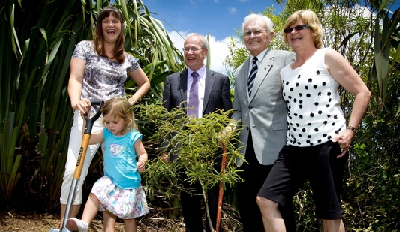Looking back over 50 years of regional park history

Rich Regional Parks Inheritance: All Aucklanders now share a rich regional parks inheritance, thanks to Arnold R Turner CMG who did more than any other person to realise the Frederick Jones’ dream, initially thwarted when the government refused to purchase most of the land behind Ōrewa Beach, which was then going for a pittance. Turner, daughter, granddaughter and great granddaughter, and Mayor Len Brown, marking the 50th anniversary of passing of legislation that paved the way to creating the inheritance. photographer Sarah Ivey
In the early 1960s, Mr F W O Jones, Auckland’s regional planning officer, was concerned at the rapid growth of urban development along Auckland’s coastline, which was preventing all but a favoured few from having access to good beaches.
He recommended that large properties like Wenderholm and Long Bay, which were then in private ownership, should be purchased, kept in their natural state and opened to the public as regional parks. But at that time, there were more that 25 city, borough and county councils in the region. None of them was willing or able to take the financial responsibility for purchasing them and opening them to the public.
At that time, the mayor of Auckland city was Mr D M Robinson—later Sir Dove-Meyer Robinson, but always popularly referred to as ‘Robbie’. He had a regional vision and was largely instrumental in having the city council promote a bill that would create a regional authority. So it came about that the bill was passed late in 1963 creating the Auckland Regional Authority. Thereby, Auckland was given the means to turn Mr Jones’, vision into a reality.
Membership of the first regional authority was to be constituted of representatives nominated by the councils in the region and by the ad hoc bodies whose functions the new authority was to take over. At the time, I was the chairman of the Auckland Centennial Memorial Park Board, whose functions were to be taken over, and the Board nominated me to be a member of the new authority.
Because I had come from a park board, the new authority made me the chairman of its regional parks committee, a position that I held from 1963 until 1968. And so it came about that it was my privilege to have a part in the decisions to purchase the Wenderholm and Long Bay properties—the first under this new programme (Auckland already had major areas of native bush parkland in the Waitakere Ranges). Wenderholm was opened to the public as a regional park in December 1965 and over the next 6 weeks nearly 50 000 people enjoyed a visit to our new park. What has happened in the years since that summer?
In 1965, none of us imagined that Aucklanders would have so caught the regional park vision that by now, Auckland would have a total of 26 regional parks, most of them completely new parks. Nor could we have imagined then that the function of regional parks would have widened significantly and that the number of visitors to them would increase so enormously. At the outset our objective was to provide public access to beaches. But when the authority purchased the Shakespear property, it purchased a working farm as well as its beaches.
And the acquisition of other farm parks followed. So that now, the Auckland Council is the largest farmer in the region. These farm parks perform an important educative purpose—they teach people, and especially city children, something about rural life, the care of animals and the importance of farming in supplying our food.
In 1965 we saw the primary purpose of regional parks as being to provide large recreational areas for the public in natural settings. But soon another important purpose was added, that of the conservation and restoration of the natural environment. Many of us assume that what we see when we visit a regional park today has always existed in its present state. But that is not so. In addition to the facilities provided for the public, millions of trees have been planted, wetlands and other areas fenced out and other conservation works done to improve the quality of the environment. And natural regeneration continues un-noticed. Some regional parks notably Shakespear, have been transformed from their original condition.
Furthermore, the conservation work has expanded to include the protection of native birds and other creatures. In 1963, no-one thought that we should create ‘mainland islands’ such as the one we now have at Tawharanui, specifically created to bring back and protect native bird-life, or that park staff would be involved in a kokako restoration programme in the Hunua Ranges.
Nor did we anticipate the extent to which the public would become involved in the care and protection of our regional parks. A huge amount of voluntary work is now being done by ‘Friends’ groups and many others, work which helps to maintain and improve our parks. And who of us would have thought years ago people would be able to enjoy ‘bach’ holidays on several regional parks?
The 50 000 visitors in the 1965–1966 season have multiplied over 100 times. Our regional parks now offer a wide variety of recreational and environmental experiences which each year are enjoyed by people of many different ethnicities The parks make a very important contribution to the quality of life enjoyed by Aucklanders. We have a network unsurpassed anywhere else in the world, provided and maintained by Aucklanders for Aucklanders.
May all Aucklanders continue to care for and pass on that inheritance.
Founder Downplays His Role Although he assiduously ascribes principal credit for the vision for Auckland’s regional park network to Frederick W O Jones, former land court judge Arnold R Turner CMG deserves equal billing, as it was he who drafted the clauses of the Auckland Regional Authority Act 1963 that provided for the purchase of land for regional parks.
